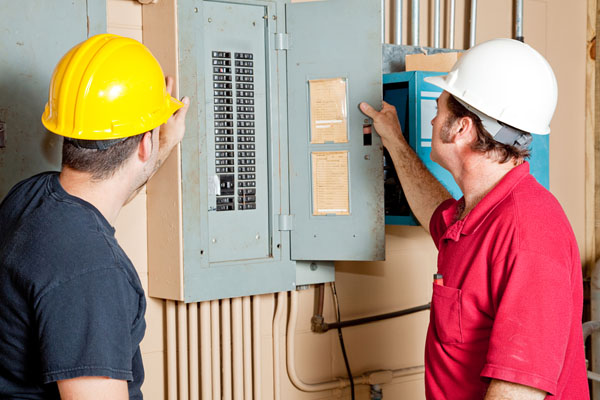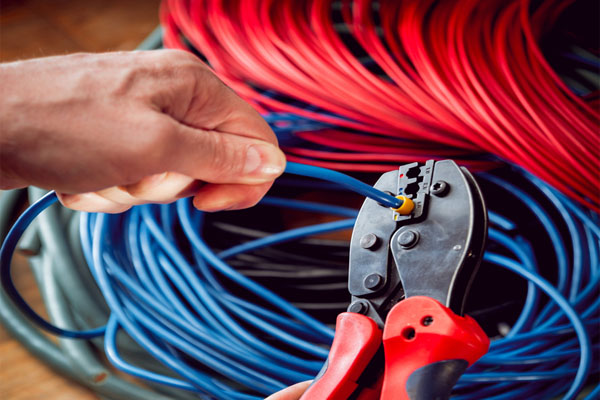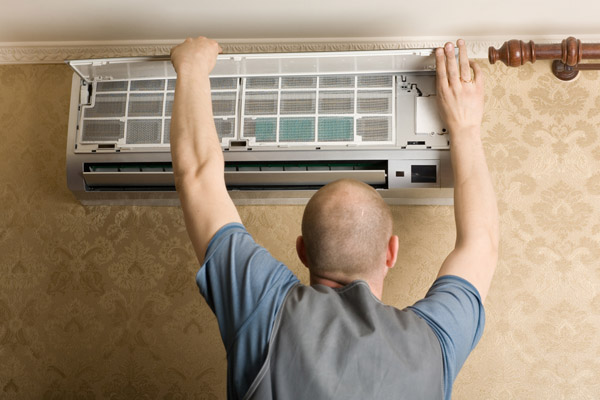Ductless Mini-Split Wiring
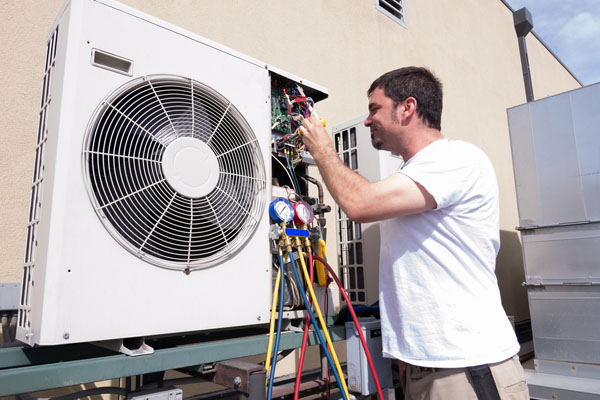
Mini-splits are an energy-efficient and popular choice for heating and cooling your home or business. It is made up of two components, namely, the outdoor unit and the indoor unit. The outdoor unit houses the compressor and condenser. Whereas, the indoor unit is what provides the warm or cold air throughout the different zones in the house.
Installing mini-splits is quicker and easier compared to central heating and cooling systems. They aren’t quite like window ACs, which you only need to plug in after you have mounted it properly. Mini-splits need their own electrical line that is connected to the house’s electrical panel.
If you are thinking of purchasing a mini-split system, it is best to contact a ductless expert. A professional can help you with all the wiring that needs to be done with your system. The technician has the training, skills, and experience to ensure that your mini-split will work at optimum capacity and performance.
Ductless Heat Pump Wiring: Things You Should Know
Contents
In this article, we will talk about all the things you need to learn regarding ductless mini-split wiring. This is to make sure that your system works at peak efficiency for a long time.
Electrical Service
The outdoor unit gets its power supply from the electrical service panel. For safety purposes, it operates with the use of a surge protector and a disconnect box. These are connected through electrical wires that are housed by a weather-proof wire known as a whip.
Mini-splits have particular power requirements that are dependent on the model and size. Generally, most systems need 220 volts or higher, but a few of the 9k to 12k systems may only need a 110-volt service. The breaker panel needs to be sized correctly. This ensures that they can take on additional voltage as these systems must be permanently connected into the electrical service panel.
It is recommended that you contact a professional HVAC technician to assist you with all the necessary electrical wirings of your system. This way, you can be sure that the work is follow code requirements and that your mini-split system’s warranty remains intact.
Wire Gauges
Mini-split systems require precise wire gauge or thickness. The connecting wire should be of high-quality and should be the right gauge. Otherwise, it can be dangerous. The connecting cable should also be UL-listed and is evaluated for sun exposure. A wire that is UL-listed means that it has passed the Underwriters Laboratories’ safety tests. An expert technician can help check that you have the electrical wiring that meets all these requirements.
Standard wire sizes are 2, 6, 8, 10, 14, and 16-gauge wire. The amount of current that can safely pass through the wire is determined by its thickness. The lower the wire gauge, the thicker it is. This also indicates that it handles more current. Whereas, a higher wire gauge means that it is thinner and can conduct less current. For instance, a #6 cable can handle 60 amps, while a #14 wire can run 15 amps.
Connecting Cable
A connecting cable, also called the four-conductor cable, is a specialized wire between the indoor unit and the outdoor unit. Its primary functions are to supply power and carry information between the two components of the mini-split. Most systems use a 14 AWG 4-conductor stranded cable. It is also typically run through a conduit to comply with local codes.
Disconnect Box: Non-Fused Versus Fused
A disconnect box, otherwise called a switch box or a fuse box, contains the controls which supply the energy to your mini-split. It lets an HVAC professional turn off the power to your mini-split when they are conducting repairs or maintenance on your system. If you are wondering whether you need one or not, then the answer is you must have one. After all, it is mandated by code that you install one near the condenser.
Surprisingly, more homeowners prefer a non-fused disconnect box over a fused one. One of the reasons for this is because the breaker in the service panel has the necessary protection a fuse would also provide. Another reason is that homeowners can reset circuit breakers. Whereas, a fuse needs to be replaced. It is also hard to find fuses, and not many people are comfortable with replacing fuses themselves. Fuses also get damaged by the elements, which in turn renders the system unsafe.
Electrical Whip
The electrical whip can be found outdoors. It is made up of high-voltage wires that are hidden in a case to protect it from the rain, sun, and other elements. They are primarily used to connect the 120v/220v power from the disconnect box to the condenser.
How An HVAC Contractor Wires A Mini-Split
After we have talked about the different types of wiring your mini-split needs, the next step is finding out how to wire up a mini-split accurately. Keep in mind that installing a mini-split is not as easy as it looks. Unless you are a licensed HVAC contractor and have a high level of electrical knowledge, it is not recommended for you to conduct a DIY mini-split installation. Otherwise, you might harm yourself and the unit. It is best that you hire a professional to get the job done.
Here is a step-by-step procedure that a professional might do when installing a mini-split in your home:
Step 1: Install A Disconnect Box
To adhere to the code, installing a disconnect box is a requirement. A professional will run a 230/208- or 155-volt line from the house’s primary break box to the area where the disconnect box will be installed. This area is typically next to your unit. An expert technician will also ensure that the required voltage is met as this is dependent on the system you have.
The two hot leads are wired to the fused connections in the box and the ground to the provided connection. After this, the faceplate will be attached and the on/off switch is inserted.
Step 2: Attach The Electrical Wire Whip
A technician will also run an electrical whip from the disconnect box to the unit. An electrical whip is an outdoor grade wire that allows you to meet the code while keeping the process simple.
Step 3: Connect The Wires To The Ductless Heat Pump
The electrical wires will then be connected to your mini-split following your unit’s specifications. The exact details of the connection depend on the mini-split make and model. A technician has all the knowledge and experience to work on any kind of mini-split so there should be no problem when connecting the electrical wires.
Step 4: Connect The Wires From The Indoor Unit To The Outdoor Unit
The number of connections you have depends on whether the space you have requires a single-zone or a multi-zone unit. If it is a multi-zone one, then it is likely that a professional will number the indoor units for easy cross-referencing. This way, it is easier to connect the wire color to the specific number. A technician will also make sure that each indoor unit in a multi-zone system is connected to the same input that its line set is wired to. This is a vital thing to do as your mini-split will not function properly if this is not correctly executed.
Step 5: Connect The Wires In The Ductless Indoor Air Handler
Like in the outdoor unit, the connections in the indoor unit must be made in the correct order. The three main wires and the ground wire must be connected to the correct terminals. Some manufacturers require the use of round crimp-style terminals to ensure that the connection is more secure. A professional can assess whether this is recommended in your specific installation process.
Once all of these steps are done, the electrical part of the installation is finished. If you have any further concerns and questions regarding the electrical wiring of your mini-split system, do not hesitate to contact your local trusted HVAC installation expert.
Protecting Your Ductless HVAC System Investment
Purchasing any type of HVAC system is a considerable investment. Although manufacturers offer excellent warranties to cover a wide variety of unfortunate circumstances such as manufacturing defects, they may not cover damages incurred from electrical surges.
Surges can be caused by one of two things. First is by a lightning strike. The other is by a power surge or an irregularity in the power supply. A surge can cause damage to the electrical components of your mini-split system. A more severe electrical event can lead to complete system failure. When this happens, you might find yourself scrambling to replace your mini-split even if it is relatively new.
To prevent these damages, it is best that you install a surge protector. A surge protector is quick and easy to install. In fact, a licensed HVAC technician can finish the surge protector installation in 10 to 15 minutes. Installing a surge protector will also give you the peace of mind knowing that your system has the protection and additional warranty it needs.
Conclusion
For a quick and hassle-free installation, call a qualified and licensed professional. They have extensive training and years of experience to guarantee that the electrical wiring of your mini-split is accurately connected. This way, you can rest easy knowing that your mini-split will work effectively and at optimum efficiency.
Check Out One Of Our Ductless Installation Projects
Fujitsu Ductless Mini-Split Replacement Project In Salisbury, Massachusetts
Call Townsend Energy For All Of Your Home Heating And Cooling Needs
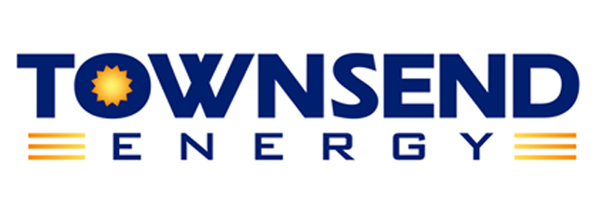
Townsend Energy is a full-service HVAC company that services residential and commercial properties throughout New England. We offer a range of heating and cooling services, including HVAC installations, repairs, tune-ups, and more. Our experienced, NATE certified professionals can find the best home heating and cooling solutions for your home while working with your budget. We aim to improve your home’s level of energy efficiency, comfort, and indoor air quality. We back our work by a warranty to ensure your satisfaction. Also, we provide free, in-home estimates. Call Townsend Energy today.
Contact us now at (800) 722-4101 to find out more!

